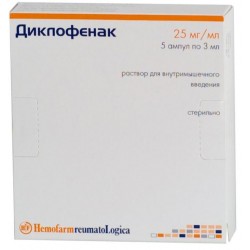




Security policy (edit with Customer reassurance module)

Delivery policy (edit with Customer reassurance module)

Return policy (edit with Customer reassurance module)
Compound
Active ingredient: diclofenac sodium,
Excipients: benzyl alcohol, water for injection
Pharmacokinetics
Diclofenac is a non-steroidal anti-inflammatory drug (NSAID). It has anti-inflammatory, analgesic and antipyretic effects. It inhibits the COX enzyme in the cascade of arachidonic acid metabolism and disrupts the biosynthesis of prostaglandins.
Indications for use
Inflammatory and inflammation-activated degenerative forms of rheumatism:
- chronic polyarthritis,
- ankylosing spondylitis (Bekhterev's disease),
- arthrosis,
- spondylarthrosis,
- neuritis and neuralgia, such as cervical syndrome, lumbago (lumbago), sciatica,
- Acute attacks of gout.
Rheumatic lesions of soft tissues.
Painful swelling or inflammation after injury or surgery.
Non-rheumatic inflammatory pain conditions.
Contraindications
Hypersensitivity (including to other NSAIDs), complete or incomplete combination of bronchial asthma, recurrent polyposis of the nose and paranasal sinuses and intolerance to ASA or other NSAIDs (including history), erosive and ulcerative lesions of the gastrointestinal tract and 12 - duodenal ulcer, active gastrointestinal bleeding, inflammatory bowel disease, severe liver and heart failure, the period after coronary artery bypass grafting, severe renal failure (CC less than 30 ml / min), progressive kidney disease, active liver disease, confirmed hyperkalemia, pregnancy (III trimester), lactation period, children's age (up to 14 years - for enteric-coated tablets 50 mg and rectal suppositories 50 mg, up to 18 years - for prolonged-release tablets and suppositories 100 mg).
For rectal use (optional): proctitis.
For LF containing lactose (optional): hereditary lactose intolerance, malabsorption of glucose-galactose, lactase deficiency.
Carefully. Peptic ulcer of the stomach and duodenum, ulcerative colitis, Crohn's disease, a history of liver disease, hepatic porphyria, chronic renal failure, chronic heart failure, arterial hypertension, a significant decrease in BCC (including after extensive surgery),
elderly patients (including those receiving diuretics, debilitated patients and those with low body weight),
bronchial asthma, simultaneous administration of corticosteroids (including prednisolone), anticoagulants (including warfarin), antiplatelet agents (including ASA, clopidogrel), selective serotonin reuptake inhibitors (including citalopram, fluoxetine, paroxetine, sertraline)
ischemic heart disease, cerebrovascular disease, dyslipidemia/hyperlipidemia,
diabetes mellitus, peripheral arterial disease, smoking, chronic renal failure (CC 30-60 ml / min), the presence of Helicobacter pylori infection, long-term use of NSAIDs, alcoholism, severe somatic diseases.
Use during pregnancy and lactation
Contraindicated.
Side effects
On the part of the digestive system: nausea, vomiting, epigastric pain, anorexia, flatulence, constipation, gastritis up to erosive with bleeding, increased activity of transaminases, drug-induced hepatitis, pancreatitis.
From the urinary system: interstitial nephritis.
From the side of the central nervous system: headache, dizziness, disorientation, agitation, insomnia, irritability, fatigue, aseptic meningitis.
From the respiratory system: bronchospasm.
From the hemopoietic system: anemia, thrombocytopenia, leukopenia, agranulocytosis.
Dermatological reactions: exanthema, erythema, eczema, hyperemia, erythroderma, photosensitivity.
Allergic reactions: erythema multiforme, Lyell's syndrome, Stevens-Johnson syndrome, anaphylactic reactions, including shock.
Local reactions: at the injection site, burning, infiltrate formation, necrosis of adipose tissue are possible.
Others: fluid retention in the body, edema, increased blood pressure.
Interaction
Diclofenac may enhance the toxic effect of cyclosporine on the kidneys. With simultaneous use with anticoagulants, regular monitoring of blood coagulation parameters is necessary. With the simultaneous use of the drug Diclofenac with digoxin, phenytoin or lithium preparations, an increase in plasma concentrations of these drugs is possible, with diuretics and antihypertensive drugs - it is possible to reduce the effect of these drugs, with potassium-sparing diuretics - hyperkalemia may develop, with acetysalicylic acid - a decrease in the concentration of diclofenac in plasma blood and increased risk of side effects. When using methotrexate within 24 hours before or after taking Diclofenac, it is possible to increase the concentration of methotrexate and increase its toxic effect. Diclofenc can cause hypo- or hyperglycemia, therefore, when used simultaneously with hypoglycemic agents, it is necessary to control the concentration of glucose in the blood.
Dosage and administration
The drug Diclofenac is administered at the beginning of treatment once in / m at a dose of 75 mg (1 ampoule) or, if necessary, a maximum of 150 mg (2 ampoules) per day only for adults and only in cases where it is necessary to obtain a particularly rapid therapeutic effect. Usually injections are prescribed for 1-5 days. V / m injections can be combined with the use of the drug orally / rectally, while the maximum daily dose should not exceed 150 mg. If it is necessary to continue therapy, they switch to taking diclofenac in the form of tablets, capsules, and the use of suppositories.